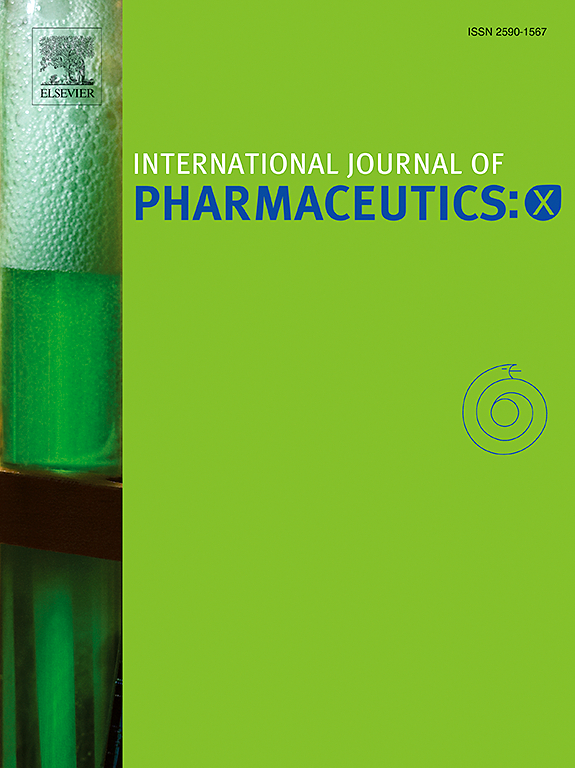Exploring the potential of antifungal-loaded proniosomes to consolidate corneal permeation in fungal keratitis: A comprehensive investigation from laboratory characterization to microbiological evaluation
IF 6.4
2区 医学
Q1 PHARMACOLOGY & PHARMACY
引用次数: 0
Abstract
This work aimed to prepare Terconazole loaded proniosomes (TCZ-PNS) utilizing modified coacervation technique for the management of fungal keratitis. Terconazole (TCZ) is a potent antifungal with poor aqueous solubility posing intricacies in its incorporation in ocular formulations. A 23 factorial design was adopted to probe independent formulation variables including A: Lecithin: cholesterol ratio, B: Surfactant: cholesterol ratio and C: Span® 80 contribution (% of total SAA). The formulae, generated by the design, were prepared and scrutinized regarding entrapment efficiency (%EE), particle size (PS), polydispersity index (PDI) and zeta potential (ZP). Numerical desirability algorithms selected an optimum TCZ-PNS which boasted plausible %EE (89.51 % ± 0.94 %), nanoscale vesicles consistent with TEM measurements (247.9 ± 0.42 nm), a sufficiently high ZP (−43.42 ± 0.85 mV), and an in-vitro biphasic release profile that remained stable even after Gamma irradiation and short-term storage. The transcorneal ex-vivo permeation of TCZ-PNS was higher than that of TCZ suspension (≈ 2-fold). The formulation was further evaluated for pH, corneal hydration threshold, and histopathological safety, confirming its suitability for ocular application. Confocal laser microscopy revealed substantial corneal uptake (approximately twice as deep as of TCZ suspension). Additionally, microbiological assessments of the optimal TCZ-PNS compared to TCZ suspension demonstrated an inhibition zone nearly 50 % larger, a significantly lower MIC and MFC (64-fold reduction), and enhanced biofilm inhibition activity across most tested concentrations. These findings suggest that TCZ-PNS could be a propitious treatment choice to deeply deliver antifungal therapy for the eradication of deeply rooted and inaccessible fungal keratitis.

探索抗真菌负载前体在真菌性角膜炎中巩固角膜渗透的潜力:从实验室表征到微生物学评估的综合调查
本研究旨在利用改良的凝聚技术制备载Terconazole原体(TCZ-PNS)用于治疗真菌性角膜炎。Terconazole (TCZ)是一种有效的抗真菌药,但其水溶性较差,在眼部配方中掺入时存在复杂性。采用23因子设计探讨A:卵磷脂:胆固醇比、B:表面活性剂:胆固醇比和C: Span®80贡献(占总SAA的百分比)的独立配方变量。根据设计生成的公式,对捕集效率(%EE)、粒径(PS)、多分散性指数(PDI)和ζ电位(ZP)进行了研究。数值优选算法选择的最佳TCZ-PNS具有合理的EE %(89.51%±0.94%),与TEM测量值一致的纳米级囊泡(247.9±0.42 nm),足够高的ZP(- 43.42±0.85 mV),以及即使在伽马辐照和短期储存后仍保持稳定的体外双相释放谱。TCZ- pns经角膜离体透性高于TCZ悬浮液(≈2倍)。进一步评估该配方的pH值、角膜水化阈值和组织病理学安全性,确认其适合眼部应用。共聚焦激光显微镜显示大量角膜摄取(大约是TCZ悬液的两倍深)。此外,与TCZ悬浮液相比,最佳TCZ- pns的微生物学评估表明,其抑制区扩大了近50%,MIC和MFC显著降低(降低64倍),并且在大多数测试浓度下生物膜抑制活性都有所增强。这些结果表明,TCZ-PNS可能是一种良好的治疗选择,可以深度提供抗真菌治疗,根除深根性和难以获得的真菌性角膜炎。
本文章由计算机程序翻译,如有差异,请以英文原文为准。
求助全文
约1分钟内获得全文
求助全文
来源期刊

International Journal of Pharmaceutics: X
Pharmacology, Toxicology and Pharmaceutics-Pharmaceutical Science
CiteScore
6.60
自引率
0.00%
发文量
32
审稿时长
24 days
期刊介绍:
International Journal of Pharmaceutics: X offers authors with high-quality research who want to publish in a gold open access journal the opportunity to make their work immediately, permanently, and freely accessible.
International Journal of Pharmaceutics: X authors will pay an article publishing charge (APC), have a choice of license options, and retain copyright. Please check the APC here. The journal is indexed in SCOPUS, PUBMED, PMC and DOAJ.
The International Journal of Pharmaceutics is the second most cited journal in the "Pharmacy & Pharmacology" category out of 358 journals, being the true home for pharmaceutical scientists concerned with the physical, chemical and biological properties of devices and delivery systems for drugs, vaccines and biologicals, including their design, manufacture and evaluation. This includes evaluation of the properties of drugs, excipients such as surfactants and polymers and novel materials. The journal has special sections on pharmaceutical nanotechnology and personalized medicines, and publishes research papers, reviews, commentaries and letters to the editor as well as special issues.
 求助内容:
求助内容: 应助结果提醒方式:
应助结果提醒方式:


